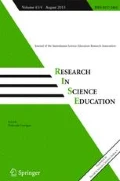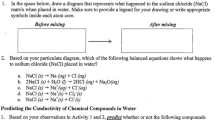Abstract
This article discusses the relation and patterns of intra- and inter-group discourse as middle school students explain particular phenomena. We present a framework of the dynamic process involved in generating collaborative knowledge. Our focus is on connecting students' thinking and experience with science concepts and explanations. Using the perspective of learning as a social activity, we are interested in science teaching that engages students in collaborative inquiry as a means for learning science content. Specifically, we examine the role of shared inquiry and the nature of consensus-building in students' development of explanations from a collaborative knowledge-building stance. Student discourse, in small (intra-group) and large (inter-group) contexts, is examined as an explicit mode of inquiry. While additional study is needed, we contend these two forms of discourse (constructive and generative; dialectic and persuasive) effectively promote progressive discourse and thereby facilitate shared coherent explanations of phenomena.
If we now consider dialectics rather than method as the logic of science, the whole image changes because of the essential, constitutive role played by interlocutors. Due to this role, science becomes a game with three players: an inquiring mind, or, more realistically, a group of the communityC 1, natureN, and another group of the communityC 2. (Pera, 1994, p. 133).
Similar content being viewed by others
References
Alexopoulou, E., & Driver, R. (1996). Small-group discussion in physics: Peer interaction modes in pairs and fours.Journal of Research in Science Teaching, 33, 1099–114.
Bereiter, C. (1994a). Implications of postmodernism for science, or, science as progressive discourse.Educational Psychologist, 29, 2–12.
Bereiter, C. (1994b). Constructivism, socioculturalism, and Popper's world 3.Educational Researcher, 23, 21–23.
Cobb, P. (1994). Where is the mind: Constructivist and sociocultural perspectives on mathematical development.Educational Researcher, 23, 13–19.
Cohen, E. (1994). Restructuring the classroom: Conditions for productive small groups.Review of Educational Research, 64, 1–35.
Damon, W., & Phelps, E. (1989). Critical distinctions among three approaches to peer education.International Journal of Educational Research, 13, 9–19.
Driver, R., Asoko, H., Leach, J., Mortimer, E., & Scott, P. (1994). Constructing scientific knowledge in the classroom.Educational Researcher, 23, 5–12
diSessa, A. (1993). Phenomenology and the evolution of intuition. In D. Gentner & A. Stevens (Eds.),Mental models (pp. 15–33). New Jersey: Lawrence Erlbaum Associates.
Dunbar, K. (1995). How scientists really reason: Scientific reasoning in real-world laboratories. In R. J. Sternberg & J. Davidson (Eds.),The nature of insight (pp. 365–395). Cambridge MA: MIT Press.
Feher, E., & Rice, K. (1988). Shadow and anti-images: Children's conceptions of light and vision II.Science Education, 72, 637–649.
Hammer, D. (1995). Student inquiry in a physics classroom.Cognition and Instruction, 13, 401–430.
Gruenfeld, D., & Hollingshead, A. (1993). Sociocognition in work groups: The evolution of group integrative complexity and its relation to task performance.Small Group Research, 24, 383–405.
Johnson, E., & Johnson, F. (1987).Joining together: Group theory and group skills. New Jersey: Prentice-Hall, Inc.
Klaassen, C., & Lijnse, P. (1996). Interpreting students' and teachers' discourse in science classes: An underestimated problem?Journal of Research in Science Teaching, 33, 115–134.
Latour, B. (1987).Science in action: How to follow scientists and engineers through society. Milton Keynes: Open University Press.
Maturana, H., & Varela, F. (1992).The tree of knowledge. Boston: Shambhala.
Meyer, K., & Woodruff, E. (1997). Consensually driven explanation in science teaching.Science Education, 81, 175–194.
Miller, M. (1987). Argumentation and cognition. In M. Hickmann (Ed.),Social and functional approaches to language and thought (pp. 225–249). Orlando: Academic Press.
Nastasi, B., & Clements, K. (1991). Research on cooperative learning: Implications for practice.School Psychology Review, 20, 110–131.
Newman, D. (1986). The role of mutual knowledge in the development of perspective taking.Developmental Review, 6, 122–145.
Pera, M. (1994).Discourses of science. Chicago: University of Chicago Press.
Rennie, L., & Parker, L. (1987). Detecting and accounting for gender differences in mixed-sex and single-sex groupings in science lessons.Educational Review, 39, 65–73.
Rice, K., & Feher, E. (1987). Pinholes and images: Children's conceptions of light and vision, II.Science Education, 71, 629–639.
Richmond, G., & Striley, J. (1996). Making meaning in classrooms: Social processes in small-group discourse and scientific knowledge building.Journal of Research in Science Teaching, 33, 839–858.
Roschelle, J. (1992). Leaning by collaborating: Convergent conceptual change.The Journal of the Learning Sciences, 2, 235–276.
Roth, W.-M. (1996). Knowledge diffusion* in a grade 4–5 classroom during a unit on civil engineering: An analysis of a classroom community in terms of its changing resources and practices.Cognition and Instruction, 14, 179–220.
Roth, W.-M., & Bowen, G. (1995). Knowing and interacting: A study of culture, practices, and resources in a grade 8 open-inquiry science classroom guided by a cognitiveapprenticeship metaphor.Cognition and Instruction, 13, 73–128.
Scardamalia, M., & Bereiter, C. (1994). Computer supports for knowledge-building communities.The Journal of the Learning Sciences, 3(3), 265–283.
Scardamalia, M., Bereiter, C., McLean, R., Swallow, J., & Woodruff, E. (1989). Computer supported intentional learning environments.Journal of Educational Computing Research, 5, 51–68.
Slavin, R. (1989). Cooperative learning and student achievement: Six theoretical perspectives. In M. Maehr (Ed.),Advances in motivation and achievement: Motivation enhancing environments. (Vol. 6) (pp. 167–177). London: JAI Press.
Solomon, J. (1994). The rise and fall of constructivism.Studies in Science Education, 23, 1–19.
Author information
Authors and Affiliations
Corresponding author
Rights and permissions
About this article
Cite this article
Woodruff, E., Meyer, K. Explanations from intra- and inter-group discourse: Students building knowledge in the science classroom. Research in Science Education 27, 25–39 (1997). https://doi.org/10.1007/BF02463030
Issue Date:
DOI: https://doi.org/10.1007/BF02463030




